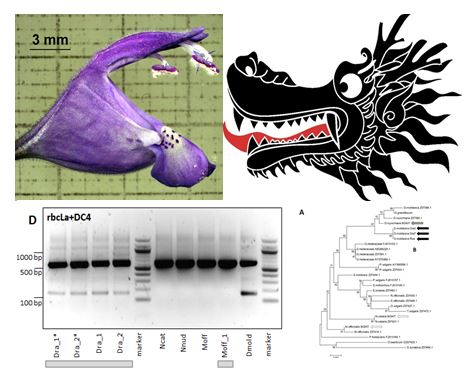2014_02 Der Wahre Drachenkopf
What is the question?
Health Food is getting popular. In the age of globalisation more and more products from the Interphase between food and medicine invade the European market. Ayurveda or Traditional Chinese Medicine are the best known. But how do consumers know, whether the package contains that what is declared? For the often exotic components of Teas and herb mixtures this is far from certain. The authorities have a hard time to control these products. Who knows the plants? Who can verify the products made from them? Since years, our Applied Biodiversity Group develops new strategies for consumer protection. This time, we have created an assay to authenticate Moldavian Dragonhead (Dracocephalum moldavica), a new miracle herb from Central Asia. The request for this incredibly lemon-scented herb is booming, since it is clear that it not only smells nicely, but cures coronary diseases and chronic pains. The production for this fashion herb cannot keep pace - therefore the similar looking Melissa or Cat Mint is used as so called surrogates...
What is our solution?
We have subjected Dragonhead, Melissa and Cat Mint to genetic barcoding. Similar to the barcode in the super market, something is fingerprinted - here we search for appropriated gene markers that are specific for a plant species. Based on this marker, the plant can be distinguished from its surrogate species. We could find a suited sequence difference in one of the genes that are usually used for barcoding. However, the difference was minute - just one base pair! To sequence a commercial sample to detect this difference, would be not a good assay. We therefore used molecular scissors, so called restriction enzymes. We found two of these molecular scissors, cutting differently for the Dragonhead gene as compared to Melissa or Cat Mint. The Problem with this approach termed RFLP (for Restriction Fragment Length Polymorphism) is the need for cutting with two different scissors to get a clear result. Each scissor needs half a day for the cut - this approach would therefore be too lengthy. We tried a faster alternative based on PCR (the well-known polymerase chain reaction, used by the police in forensics). To this PCR we add a finely adjusted disturbing primer. This primer can bind the Dragonhead gene, but not the corresponding genes from Melissa and Cat Mint. This will produce in samples from "true" Dragonhead a smaller side band that can be seen when the PCR product is separated on a gel. This band is absent in the surrogates Melissa and Cat Mint.
What does this mean?
By this so called ARMS assay, we can clearly detect in short time (3 hours), whether a commercial sample really contains material of the Dragonhead genus. A sample, where Dragonhead were replaced by Melissa or Cat Mint, would not yield a positive Signal. The method can now be used for routine tests. What we still cannot do is to tell that the detected Dragonhead is really the Moldavian type. We therefore work currently to get finer probes.
Publication
102. Horn T, Völker J, Rühle M, Häser A, Jürges G, Nick P (2014) Genetic authentication by RFLP versus ARMS? The case of Moldavian Dragonhead (Dracocephalum moldavica L.). Eur Food Sci Technol 238, 93-104 - pdf

